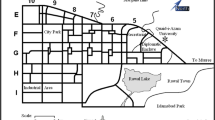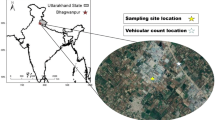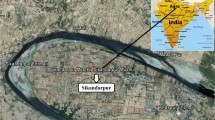Abstract
Fine atmospheric particulates are associated with numerous environmental and health issues as they can penetrate deeply in the respiratory tract thereby adversely affecting the human health. This study aimed to investigate the concentrations of trace elements in the respirable (PM2.5) fraction of the atmospheric particulates and to understand their pollution status and health risks. The samples were collected from Islamabad, and the metals were extracted using HNO3 and HCl based extraction method. Atomic absorption spectroscopy was employed to quantify the concentrations of selected trace elements. PM2.5 exhibited considerable variations in their minimum (4.737 µg/m3) and maximum (108.1 µg/m3) levels. The significant contributors among the selected elements bound to PM2.5 were Ca (1016 ng/m3), K (759.8 ng/m3), Mg (483.0 ng/m3), Fe (469.7 ng/m3), and Zn (341.1 ng/m3), while Ag (0.578 ng/m3) was found at the lowest levels with an overall descending order: Ca > K > Mg > Fe > Zn > Cu > Pb > Ni > Cd > Mn > Sr > Cr > Co > Li > Ag. Multivariate PCA and CA identified industrial activities, combustion processes and automobile emissions as the main anthropogenic contributors to particulate pollution. Enrichment factors and geoaccumulation indices were computed to assess the pollution status. The results also revealed that among the trace elements, Cd showed extremely high contamination, followed by Ag, Zn, and Pb, which showed moderate to high contamination in the atmospheric particulates. Carcinogenic health risks from Pb and Ni were found to be within the safe limit (1.0 × 10–6); however, Cr, Co, and Cd exposure was linked to significant cancer risks. The present elemental levels in PM2.5 were also compared with the reported levels from other regions around the world.




Similar content being viewed by others
Availability of data and material
The datasets used for this study are available upon reasonable request to the corresponding author.
Code availability
Not applicable.
References
Ahmad, M., Yu, Q., Chen, J., Cheng, S., Qin, W., & Zhang, Y. (2021). Chemical characteristics, oxidative potential, and sources of PM2.5 in wintertime in Lahore and Peshawar, Pakistan. Journal of Environmental Sciences, 102, 148–158.
Alias, N. F., Khan, M. F., Sairi, N. A., Zain, S. M., Suradi, H., Rahim, H. A., Banerjee, T., Bari, M. A., Othman, M., & Latif, M. T. (2020). Characteristics, emission sources, and risk factors of heavy metals in PM2.5 from Southern Malaysia. ACS Earth and Space Chemistry, 14, 1309–1323.
Alves, C., Evtyugina, M., Vicente, E., Vicente, A., Rienda, I. C., de la Campa, A. S., Tomé, M., & Duarte, I. (2023). PM2.5 chemical composition and health risks by inhalation near a chemical complex. Journal of Environmental Sciences, 124, 860–874.
Anjum, M. S., Ali, S. M., Subhani, M. A., Anwar, M. N., Nizami, A. S., Ashraf, U., & Khokhar, M. F. (2021). An emerged challenge of air pollution and ever-increasing particulate matter in Pakistan; a critical review. Journal of Hazardous Materials, 402, 123943.
Bayat, R., Ashrafi, K., Motlagh, M. S., Hassanvand, M. S., Daroudi, R., Fink, G., & Künzli, N. (2019). Health impact and related cost of ambient air pollution in Tehran. Environmental Research, 176, 108547.
Behrooz, R. D., Kaskaoutis, D. G., Grivas, G., & Mihalopoulos, N. (2021). Human health risk assessment for toxic elements in the extreme ambient dust conditions observed in Sistan, Iran. Chemosphere, 262, 127835.
Brodny, J., & Tutak, M. (2021). The analysis of similarities between the European Union countries in terms of the level and structure of the emissions of selected gases and air pollutants into the atmosphere. Journal of Cleaner Production, 279, 123641.
CEN. (2005). Ambient air quality - Standard gravimetric measurement method for the determination of the PM2.5 mass fraction of suspended particulate matter. EN 14907:2005. Brussels, Belgium: Comité Européen de Normalisation (CEN; European Committee for Standardization).
Chen, S. L., Chang, S. W., Chen, Y. J., & Chen, H. L. (2021). The possible warming effect of fine particulate matter in the atmosphere. Communications Earth & Environment, 2, 1–9.
Dhammapala, R., Basnayake, A., Premasiri, S., Chathuranga, L., & Mera, K. (2022). PM2.5 in Sri Lanka: Trend analysis, low-cost sensor correlations and spatial distribution. Aerosol and Air Quality Research, 22, 210266.
Farahani, V. J., Soleimanian, E., Pirhadi, M., & Sioutas, C. (2021). Long-term trends in concentrations and sources of PM2.5–bound metals and elements in central Los Angeles. Atmospheric Environment, 15, 118361.
George, S., Chua, M. L., ZheWei, D. Z., Das, R., Bijin, V. A., Connolly, J. E., Lee, K. P., Yung, C. F., Teoh, O. H., & Thomas, B. (2020). Personal level exposure and hazard potential of particulate matter during haze and non-haze periods in Singapore. Chemosphere, 243, 125401.
Guo, W., Zhang, B., Wei, Q., Guo, Y., Yin, X., Li, F., Wang, L., & Wang, W. (2021). Estimating ground-level PM2.5 concentrations using the two-stage model in Beijing-Tianjin-Hebei, China. Atmospheric Pollution Research, 12, 101154.
Habre, R., Girguis, M., Urman, R., Fruin, S., Lurmann, F., Shafer, M., Gorski, P., Franklin, M., McConnell, R., Avol, E., & Gilliland, F. (2021). Contribution of the tailpipe and non-tailpipe traffic sources to quasi-ultrafine, fine and coarse particulate matter in Southern California. Journal of the Air & Waste Management Association, 71, 209–230.
Jain, S., Sharma, S. K., Vijayan, N., & Mandal, T. K. (2020). Seasonal characteristics of aerosols (PM2.5 and PM10) and their source apportionment using PMF, a four-year study over Delhi, India. Environmental Pollution, 262, 114337. 32.
Jayarathne, A., Egodawatta, P., Ayoko, G. A., & Goonetilleke, A. (2018). Assessment of ecological and human health risks of metals in urban road dust based on geochemical fractionation and potential bioavailability. Science of the Total Environment, 635, 1609–1619.
Kalaiarasan, G., Balakrishnan, R. M., Sethunath, N. A., & Manoharan, S. (2018). Source apportionment studies on particulate matter (PM10 and PM2.5) in ambient air of urban Mangalore, India. Journal of Environmental Management, 217, 815–824.
Kayee, J., Sompongchaiyakul, P., Sanwlani, N., Bureekul, S., Wang, X., & Das, R. (2020). Metal concentrations and source apportionment of PM2.5 in Chiang Rai and Bangkok, Thailand during a biomass burning season. ACS Earth and Space Chemistry, 19, 1213–1226. 21.
Kermani, M., Jafari, A. J., Gholami, M., Arfaeinia, H., Shahsavani, A., & Fanaei, F. (2021). Characterization, possible sources and health risk assessment of PM2.5-bound Heavy Metals in the most industrial city of Iran. Journal of Environmental Health Science and Engineering, 19, 151–163.
Li, W., Shao, L., Li, Z., Li, H., Gao, J., Li, J., Zhang, H., Zhang, Z., Silva, L. F. O., Zhang, M., Chen, Y., & Oliveira, M. L. S. (2022). Surface chemistry of atmospheric nanoparticles during a haze episode in Beijing by TOF-SIMS. Gondwana Research, 110, 305–318.
Lima, B. D., Teixeira, E. C., Hower, J. C., Civeira, M. S., Ramírez, O., Yang, C., Oliveira, M. L. S., & Silva, L. F. O. (2021). Metal-enriched nanoparticles and black carbon: A perspective from the Brazil railway system air pollution. Geoscience Frontiers, 12(3), 101129.
Liu, Y., Li, C., Zhang, C., Liu, X., Qu, Y., An, J., Ma, D., Feng, M., & Tan, Q. (2020). Chemical characteristics, source apportionment, and regional contribution of PM2.5 in Zhangjiakou, Northern China: a multiple sampling sites observation and modelling perspective. Environmental Advances, 3, 100034.
Lv, D., Chen, Y., Zhu, T., Li, T., Shen, F., Li, X., & Mehmood, T. (2019). The pollution characteristics of PM10 and PM2.5 during summer and winter in Beijing, Suning and Islamabad. Atmospheric Pollution Research, 10, 1159–1164.
Mehmood, T., Ahmad, I., Bibi, S., Mustafa, B., & Ali, I. (2020). Insight into monsoon for shaping the air quality of Islamabad, Pakistan, Comparing the magnitude of health risk associated with PM10 and PM2.5 exposures. Journal of the Air & Waste Management Association, 70, 1340–1355.
Mehmood, T., Tianle, Z., Ahmad, I., Li, X., Shen, F., Akram, W., & Dong, L. (2018). Variations of PM2.5, PM10 mass concentration and health assessment in Islamabad, Pakistan. Earth and Environmental Science, 133, 012031.
Method IO-3.1. (1999). Selection, Preparation and Extraction of Filter Material. EPA/625/R-96/010a. Compendium of Methods for the Determination of Inorganic Compounds in Ambient Air. US-Environmental Protection Agency, Cincinnati, OH.
Method IO-3.2. (1999). Determination of Metals in Ambient Particulate Matter Using Atomic Absorption (AA) Spectroscopy. EPA/625/R-96/010a. Compendium of Methods for the Determination of Inorganic Compounds in Ambient Air. US-Environmental Protection Agency, Cincinnati, OH.
Nair, M., Bherwani, H., Kumar, S., Gulia, S., Goyal, S. K., & Kumar, R. (2020). Assessment of the contribution of agricultural residue burning on air quality of Delhi using remote sensing and modelling tools. Atmospheric Environment, 230, 117504.
Oliveira, M. L., Neckel, A., Pinto, D., Maculan, L. S., Zanchett, M. R., & Silva, L. F. (2021). Air pollutants and their degradation of a historic building in the largest metropolitan area in Latin America. Chemosphere, 277, 130286.
Pak-EPA. (2010). National Environmental Quality Standards for Ambient Air. Environment Protection Department, The Ministry of Environment, Islamabad, Pakistan.
Phan, C. C., Nguyen, T. Q., Nguyen, M. K., Park, K. H., Bae, G. N., Seung-bok, L., & Bach, Q. V. (2020). Aerosol mass and major composition characterization of ambient air in Ho Chi Minh City, Vietnam. International Journal of Environmental Science and Technology, 17, 3189–3198.
Qin, S., Li, B., Wang, X., Huang, H., Zeng, M., Xiao, F., & Xu, X. (2020). Metal element detection and carcinogenicity risk assessment of PM2.5 samples. Environmental Toxicology and Chemistry, 39, 1273–1276.
Rahman, M. M., Begum, B. A., Hopke, P. K., Nahar, K., & Thurston, G. D. (2020). Assessing the PM2.5 impacts of biomass combustion in megacity Dhaka, Bangladesh. Environmental Pollution, 264, 14798.
Ramírez, O., da Boit, K., Blanco, E., & Silva, L. F. O. (2020). Hazardous thoracic and ultrafine particles from road dust in a Caribbean industrial city. Urban Climate, 33, 100655.
Ramírez, O., Sánchez de la Campa, A. M., Amato, F., Moreno, T., Silva, L. F., & de la Rosa, J. D. (2019). Physicochemical characterization and sources of the thoracic fraction of road dust in a Latin American megacity. Science of the Total Environment, 652, 434–446.
Rasheed, A., Aneja, V. P., Aiyyer, A., & Rafique, U. (2015). Measurement and analysis of fine particulate matter (PM2.5) in urban areas of Pakistan. Aerosol and Air Quality Research, 15, 426–439.
Rojas, J. C., Sánchez, N. E., Schneider, I., Oliveira, M. L. S., Teixeira, E. C., & Silva, L. F. O. (2019). Exposure to nanometric pollutants in primary schools: Environmental implications. Urban Climate, 27, 412–419.
Sahu, S. K., Mangaraj, P., Beig, G., Tyagi, B., Tikle, S., & Vinoj, V. (2021). Establishing a link between fine particulate matter (PM2.5) zones and COVID-19 over India based on anthropogenic emission sources and air quality data. Urban Climate, 38, 100883.
Schwela, D. H., & Haq, G. (2020). Strengths and weaknesses of the WHO urban air pollutant database. Aerosol and Air Quality Research, 20, 1026–1037.
Sharma, S. K., Mandal, T. K., Jain, S., Sharma, A., & Saxena, M. (2016). Source apportionment of PM2.5 in Delhi, India using PMF model. Bulletin of Environmental Contamination and Toxicology, 97, 286–293.
Silva, L. F., Schneider, I. L., Artaxo, P., Nunez-Blanco, Y., Pinto, D., Flores, E. M., Gomez-Plata, L., Ramírez, O., & Dotto, G. L. (2022). Particulate matter geochemistry of a highly industrialized region in the Caribbean: Basis for future toxicological studies. Geoscience Frontiers, 13, 101115.
Soleimani, M., Amini, N., Sadeghian, B., Wang, D., & Fang, L. (2018). Heavy metals and their source identification in particulate matter (PM2.5) in Isfahan City, Iran. Journal of Environmental Sciences, 72, 166–175.
State of Global Air Report. (2020). Retrieved November 11, 2020, from https://www.stateofglobalair.org/
Tong, S. (2019). Air pollution and disease burden. Lancet Planetary Health, 3, 49–50.
USEPA. (2016a). Regional Screening Levels (RSLs) - Generic Tables. Retrieved December 21, 2020, from https://www.epa.gov/risk/regional-screening-levels-rsls-generic-tables-may-2016
USEPA. (2016b). Technical Assistance Document for the Reporting of Daily Air Quality-the Air Quality Index (AQI). Office of Air Quality Planning and Standards, US-Environmental Protection Agency, Cincinnati, OH.
Vural, E. (2020). Investigation of experienced air pollution on selected pollutants scale in Kırıkkale City (2018–2019), Kastamonu University. Journal of Engineering and Sciences, 6, 41–50.
Wang, Q., Luo, K., Fan, J., Gao, X., & Cen, K. (2019). Spatial distribution and multiscale transport characteristics of PM2.5 in China. Aerosol and Air Quality Research, 19, 1993–2007.
WHO. (2019). Mortality and Burden of Disease from Ambient Air Pollution. World Health Organization. Retrieved April 17, 2019, from https://www.who.int/airpollution/ambient/en/1
WHO. (2021a). Ambient (Outdoor) Air Quality and Health. World Health Organization. Retrieved November 12, 2021, from https://www.who.int/news-room/fact-sheets/detail/
WHO. (2021b). New WHO Global Air Quality Guidelines Aim to Save Millions of Lives from Air Pollution, World Health Organization. Retrieved September 25, 2022, from https://www.int/news/item/
Zhang, J., Zhou, X., Wang, Z., Yang, L., Wang, J., & Wang, W. (2018). Trace elements in PM2.5 in Shandong Province: Source identification and health risk assessment. Science of the Total Environment, 15, 558–577.
Zhao, K., Zhang, Y., Shang, J., Schauer, J. J., Huang, W., Tian, J., Yang, S., Fang, D., & Zhang, D. (2023). Impact of Beijing’s “Coal to Electricity” program on ambient PM2.5 and the associated reactive oxygen species (ROS). Journal of Environmental Sciences, 133, 93–106.
Zheng, X., Xu, X., Yekeen, T. A., Zhang, Y., Chen, A., Kim, S. S., Dietrich, K. N., Ho, S. M., Lee, S. A., Reponen, T., & Huo, X. (2014). Ambient air heavy metals in PM2.5 and potential human health risk assessment in an informal electronic-waste recycling site of China. Aerosol and Air Quality Research, 16, 388–397.
Acknowledgements
The research facilities provided by Quaid-i-Azam University, Islamabad, Pakistan to carry out this project are thankfully acknowledged.
Funding
Funding provided by the Higher Education Commission, Government of Pakistan to complete this project (NRPU Project No. 6176) is gratefully acknowledged.
Author information
Authors and Affiliations
Contributions
Rashida Nazir: Data curation; Investigation; Methodology; Validation; Formal analysis; Writing—original draft. Munir H. Shah: Conceptualization; Validation; Visualization; Funding acquisition; Project administration; Resources; Software; Supervision; Writing—review & editing. All authors have read, understood, and have complied as applicable with the statement on "Ethical responsibilities of Authors" as found in the Instructions for Authors”.
Corresponding author
Ethics declarations
Conflicting interests
The authors have no relevant financial or non-financial interests to disclose.
Additional information
Publisher's Note
Springer Nature remains neutral with regard to jurisdictional claims in published maps and institutional affiliations.
Supplementary Information
Below is the link to the electronic supplementary material.
Rights and permissions
Springer Nature or its licensor (e.g. a society or other partner) holds exclusive rights to this article under a publishing agreement with the author(s) or other rightsholder(s); author self-archiving of the accepted manuscript version of this article is solely governed by the terms of such publishing agreement and applicable law.
About this article
Cite this article
Nazir, R., Shah, M.H. Evaluation of air quality and health risks associated with trace elements in respirable particulates (PM2.5) from Islamabad, Pakistan. Environ Monit Assess 195, 1182 (2023). https://doi.org/10.1007/s10661-023-11824-3
Received:
Accepted:
Published:
DOI: https://doi.org/10.1007/s10661-023-11824-3




